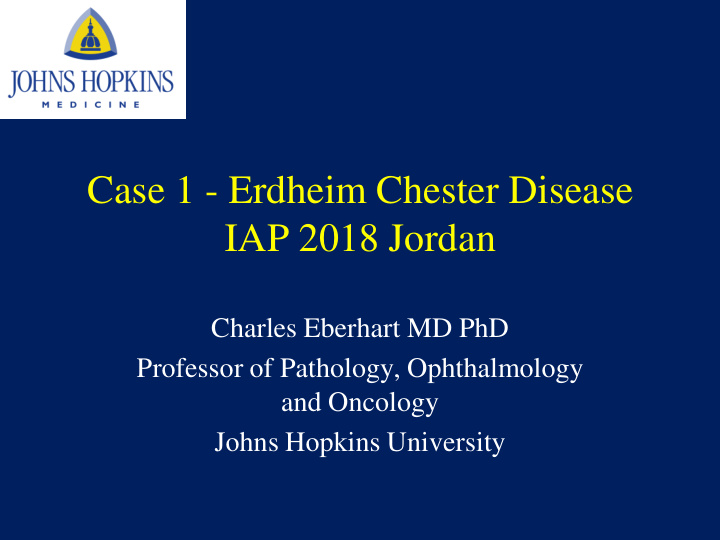



Case 1 - Erdheim Chester Disease IAP 2018 Jordan Charles Eberhart MD PhD Professor of Pathology, Ophthalmology and Oncology Johns Hopkins University
Clinical History • 58-year-old male • Waxing and waning periocular headaches • Swelling and blurred vision eventually developed (L>R). • Ophthalmologic exam – Trace left afferent pupillary defect – Extraocular movements showed about 85% of elevation of the left eye – Slit-lamp examination was unremarkable
Clinical History Radiology Findings • Bilateral intraconal masses • Intracranial masses • Pituitary, brainstem • Retroperitoneum, pericardium, periaortic soft tissue • Bone changes
CD68
S100 CD1A
BRAF (V600E) (VE1) antibody
BRAF (V600E)
Erdheim-Chester Disease Clinical Findings • Usually presents in adults • Bilateral, symmetrical bone involvement most characteristic finding • Bone pain most frequent symptom • Extraskeletal involvement>50% which may lead to diabetes insipidus, neurologic symptoms, dyspnea, pericardial effusions, kidney and liver failure
Differential Diagnosis Clinical/Orbit Adult Onset Xanthogranuloma Adult onset asthma and periocular xanthogranuloma Necrobiotic xanthogranuloma
Blood 2012 • BRAF (V600E) in 13/24 (54%) of cases of ECD, 11/29 (38%) of LCH • Absent in the remainder of non-LCH lesions tested, including Rosai-Dorfman disease, juvenile xanthogranuloma, histiocytic sarcoma, xanthoma disseminatum, interdigitating dendritic cell sarcoma, and necrobiotic xanthogranuloma
• 3 patients with refractory ECD and BRAF (V600E) mutation • Treated with the inhibitor vemurafenib • All three patients responded with a decrease in symptoms and disease burden BLOOD 2013
Clinical Follow-Up • Decreased size of brainstem lesion and mass effect • Decreased size of orbital lesions 1 month after starting vemurafenib
Acknowledgments • Prem Subramanian M.D. • Fausto Rogdriguez M.D.
Case 2 - Intraocular Extension Of An IDH Mutant Glioblastoma
Chief Complaint 42yo F with complicated PMH, presenting to JHH ED 7/17/16 for sudden vision loss in the right eye
Past Medical History Left frontal anaplastic astrocytoma, WHO Grade III Diagnosed June 2011 Tx: resection + adjuvant temozolomide Progression noted May 2015 Tx: surgical resection + Gliadel wafers + Rad (4,500 cGy) + temozolomide Bx: Glioblastoma, IDH1 mutant
Past Medical History – cont’d Feb 2016: MRI showing likely recurrence with extension into the corpus collosum – no surgical intervention Started on MEDI4736 (PD-1 Inhibitor) and Avastin infusions T1 post-contrast
MRI Brain + Orbits; MRA Head Interval progression of disease involving the left frontal and left temporal lobes, as well as the left of midline corpus callosum and adjacent parietal lobe as described above Patent intracranial vasculature T2 FLAIR Increased T2 hyperintensity of the right optic nerve . There is mild asymmetrically increased enhancement of the optic nerve sheath on the right. T1 post-Gad
Clinical Course Baseline comparison 4/28/2016
Next step? 7/22/16: Pars plana vitrectomy with biopsy Cultures – coagulase negative staph (two different strains) Cytopathology…
Vitrectomy Specimen
GFAP OLIG2
P53 ki67
IDH1 ATRX (R132H)
Thank You!
Recommend
More recommend